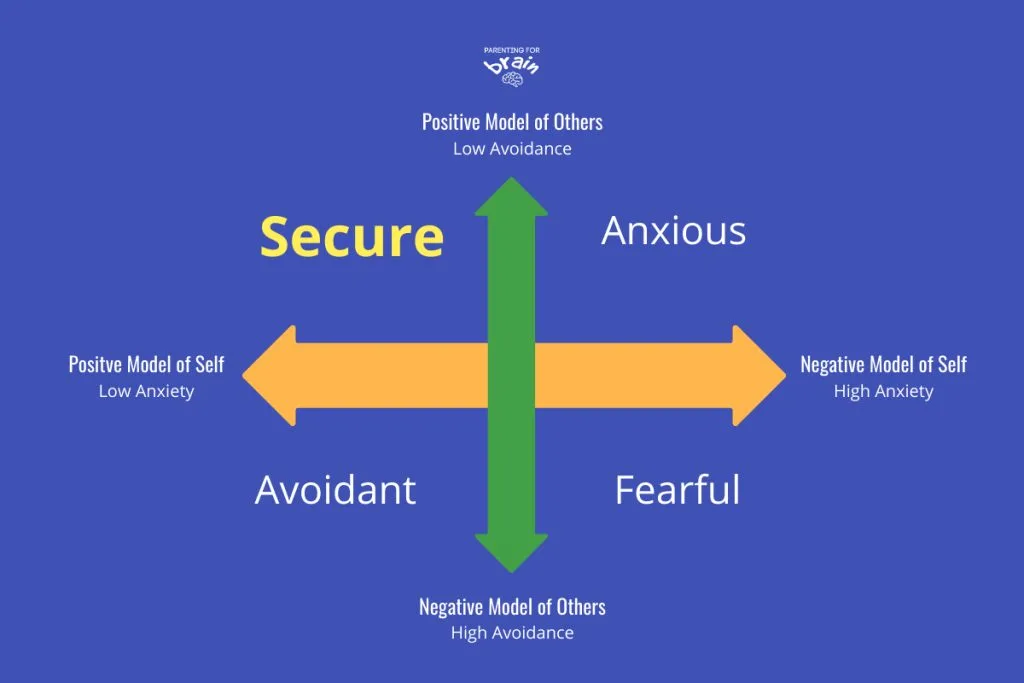TABLE OF CONTENTS
What is an Attachment?
Almost immediately after birth, infants form an emotional bond with their caregivers. Psychologists refer to this human connection as an attachment and the primary caregiver as the attachment figure. Attachment in infants can significantly affect a child’s healthy development and has been studied extensively in psychology.
Attachment style in children
A child’s attachment style is the characteristic pattern they use to maintain attachment to their primary caretaker for safety and emotional needs.
Attachment styles typically develop in the first few months of life and have an influence on the way people relate to others throughout their lives.
There are four types of attachment in children1:
- Secure attachment style
- Avoidant attachment style
- Ambivalent attachment style
- Disorganized attachment style

Out of the four patterns of attachment, avoidant attachment, ambivalent attachment, and disorganized attachment are insecure attachment styles.
This attachment classification was used in a simulated laboratory setting, called the Strange Situation procedure created by psychologist Mary Ainsworth, to identify a child’s attachment type.
In this experiment, 1-year-olds would be briefly separated from their primary caregiver and exposed to a stranger.
This mildly stressful situation helped the researchers understand how secure an infant-caregiver bond was2.
Attachment theory, formulated by British psychologist John Bowlby in the 1970s, states that infants need a secure attachment bond with a primary attachment figure to develop a healthy internal working model of relationships.
Human beings of all ages, according to Bowlby, are happiest and at their best when they are confident that their trusted “special adult” stands behind them as their secure base if difficulties arise3.
From childhood into adulthood, attachment security is a powerful predictor of a child’s social and emotional outcomes later in life.
Attachment styles in adults
Scientists have found that attachment styles also apply to romantic relationships among adults.
The attachment styles in adult relationships roughly correspond to the four styles seen in the infant-parent attachment.
They are4:
- Secure attachment style
- Avoidant attachment style
- Anxious attachment style
- Fearful attachment stylee
Adult attachment can be identified along two dimensions – anxiety and avoidance.
Generally, a secure attachment is associated with lower anxiety and avoidance, whereas an insecure attachment style with higher levels of anxiety and avoidance.
Among the four child attachment styles, secure attachment is believed to have the best characteristics of attachment.

What is secure attachment?
Secure attachment forms during child development when a child trusts that their caregivers can be relied upon to provide for their needs. Secure attachment styles tend to develop in children whose caregivers are warm and responsive. In the Strange Situation, a secure child shows signs of distress when separated from their caregivers, and happiness when they return.
Secure infants have developed a strong emotional connection with the caregiver and a feeling of safety.
Secure attachment relationships provide the infant brain with an optimal development environment.
An infant’s right brain has deep connections to the limbic and autonomic nervous systems. It is responsible for a child’s stress response and emotional development.
Signs of secure attachment in children
Children with secure attachment have the following characteristics:
- A secure child shows signs of distress when separated from their caregivers, and signs of happiness when they return to the Strange Situation.
- They are able to compose themselves quickly on the return of their caregivers5
- They are able to trust that their caregiver is a dependable adult who can be relied upon for the baby’s needs6
- They feel free to explore their surroundings and return to their caregivers for comfort or assistance because they are the base of security.
Signs of secure attachment in adults
Characteristics of secure attachment style in adults include:
- Less hostile or prone to anger7
- Less anxiety8
- Better emotional regulation
- More positive self-view and higher self-esteem9
- Better mental health and less likely to develop psychopathology even in a high-threat environment10
Impact of Secure Attachment
Secure attachment is associated with many benefits.
Secure children tend to be
- More self-reliant and independent11
- More compliance and cooperation with the parent12
- Show higher academic performance13
- Better emotional regulation skills14
- More social skills and competence15
- Less social anxiety and more socially active16
Secure attachment comes with a host of social and emotional benefits in adulthood as well.
Secure adults tend to be
- Have higher self-esteem17
- more competent
- have a stronger sense of trust in close relationships than those with insecure attachment bond
- When coping with trust violations, they use more constructive strategies which are associated with happy, intimate, friendly, and healthy relationships18
- Have higher marital satisfaction19
Secure attachment – How it develops
Secure attachment forms when a child trusts that their caregivers can be relied upon to provide for their needs.
Research finds that even the subtlest shift in parental behavior can affect attachment.
Parents of children who are securely attached are typically sensitive and responsive to their child’s needs20.
When giving commands, they tend to use an affectionate tone of voice and use a gentler physical correction21.
They also communicate comfort visually and physically through a comforting type of body language22.
They show more positive emotions than negative emotions at home23. These parents are high in independence-encouraging and acceptance24.
In the Baumrind parenting style categorization, the authoritative parenting style is the best parenting style according to research and its characteristics match the requirements for creating a secure attachment.
To children who have been mistreated previously, it is particularly important to use empathic language, attentive eye contact, and supportive body posture25.
Final Thoughts on Secure Attachment
There is no perfect parent in this world.
Don’t despair if your child hasn’t developed a secure attachment.
Although attachment patterns remain largely stable across the lifespan, experiences in the early years of life have a critical role to play26 because attachment styles do change in response to major life events.
To start the secure attachment process, parents can make adjustments in daily life to help children develop security (or avoid attachment insecurity).
Adopt a sensitive and responsive parenting style.
You can also involve a mental health professional such as psychologist or therapist to help in challenging situations.
References
- 1.Ainsworth MS. Infant–mother attachment. American Psychologist. Published online 1979:932-937. doi:10.1037/0003-066x.34.10.932
- 2.Levy KN, Blatt SJ, Shaver PR. Attachment styles and parental representations. Journal of Personality and Social Psychology. Published online 1998:407-419. doi:10.1037/0022-3514.74.2.407
- 3.Bowlby J. Attachment and loss: Retrospect and prospect. American Journal of Orthopsychiatry. Published online October 1982:664-678. doi:10.1111/j.1939-0025.1982.tb01456.x
- 4.Hazan C, Shaver P. Romantic love conceptualized as an attachment process. Journal of Personality and Social Psychology. Published online 1987:511-524. doi:10.1037/0022-3514.52.3.511
- 5.Lyons-Ruth K. Attachment relationships among children with aggressive behavior problems: The role of disorganized early attachment patterns. Journal of Consulting and Clinical Psychology. Published online 1996:64-73. doi:10.1037/0022-006x.64.1.64
- 6.Simmons BL, Gooty J, Nelson DL, Little LM. Secure attachment: implications for hope, trust, burnout, and performance. J Organiz Behav. Published online February 2009:233-247. doi:10.1002/job.585
- 7.Mikulincer M. Adult attachment style and individual differences in functional versus dysfunctional experiences of anger. Journal of Personality and Social Psychology. Published online 1998:513-524. doi:10.1037/0022-3514.74.2.513
- 8.Simard V, Moss E, Pascuzzo K. Early maladaptive schemas and child and adult attachment: A 15-year longitudinal study. Psychology and Psychotherapy: Theory, Research and Practice. Published online March 15, 2011:349-366. doi:10.1111/j.2044-8341.2010.02009.x
- 9.Bylsma WH, Cozzarelli C, Sumer N. Relation Between Adult Attachment Styles and Global Self-Esteem. Basic and Applied Social Psychology. Published online March 1997:1-16. doi:10.1207/s15324834basp1901_1
- 10.Mikulincer M, Horesh N, Eilati I, Kotler M. The association between adult attachment style and mental health in extreme life-endangering conditions. Personality and Individual Differences. Published online November 1999:831-842. doi:10.1016/s0191-8869(99)00032-x
- 11.Hong YR, Park JS. Impact of attachment, temperament and parenting on human development. Korean J Pediatr. Published online 2012:449. doi:10.3345/kjp.2012.55.12.449
- 12.Mark IL, Bakermans-Kranenburg MJ, Ijzendoorn MH. The role of parenting, attachment, and temperamental fearfulness in the prediction of compliance in toddler girls. British Journal of Developmental Psychology. Published online September 2002:361-378. doi:10.1348/026151002320620299
- 13.Moss E, St-Laurent D. Attachment at school age and academic performance. Developmental Psychology. Published online 2001:863-874. doi:10.1037/0012-1649.37.6.863
- 14.Brumariu LE. Parent-Child Attachment and Emotion Regulation. New Directions for Child and Adolescent Development. Published online June 2015:31-45. doi:10.1002/cad.20098
- 15.DiTommaso E, Brannen-McNulty C, Ross L, Burgess M. Attachment styles, social skills and loneliness in young adults. Personality and Individual Differences. Published online July 2003:303-312. doi:10.1016/s0191-8869(02)00190-3
- 16.Bohlin G, Hagekull B, Rydell A. Attachment and Social Functioning: A Longitudinal Study from Infancy to Middle Childhood. Social Development. Published online February 2000:24-39. doi:10.1111/1467-9507.00109
- 17.Wu C huei. The relationship between attachment style and self-concept clarity: The mediation effect of self-esteem. Personality and Individual Differences. Published online July 2009:42-46. doi:10.1016/j.paid.2009.01.043
- 18.Mikulincer M. Attachment working models and the sense of trust: An exploration of interaction goals and affect regulation. Journal of Personality and Social Psychology. Published online 1998:1209-1224. doi:10.1037/0022-3514.74.5.1209
- 19.Banse R. Adult Attachment and Marital Satisfaction: Evidence for Dyadic Configuration Effects. Journal of Social and Personal Relationships. Published online April 2004:273-282. doi:10.1177/0265407504041388
- 20.De Wolff MS, van Ijzendoorn MH. Sensitivity and Attachment: A Meta-Analysis on Parental Antecedents of Infant Attachment. Child Development. Published online August 1997:571-591. doi:10.1111/j.1467-8624.1997.tb04218.x
- 21.Londerville S, Main M. Security of attachment, compliance, and maternal training methods in the second year of life. Developmental Psychology. Published online 1981:289-299. doi:10.1037/0012-1649.17.3.289
- 22.Lederberg AR, Mobley CE. The Effect of Hearing Impairment on the Quality of Attachment and Mother-Toddler Interaction. Child Development. Published online October 1990:1596. doi:10.2307/1130767
- 23.Belsky J. Parent, infant, and social-contextual antecedents of father-son attachment security. Developmental Psychology. Published online 1996:905-913. doi:10.1037/0012-1649.32.5.905
- 24.McCormick CB, Kennedy JH. Parent-child attachment working models and self-esteem in adolescence. J Youth Adolescence. Published online February 1994:1-18. doi:10.1007/bf01537139
- 25.Howe D. Developmental Attachment Psychotherapy with Fostered and Adopted Children. Child and Adolescent Mental Health. Published online August 21, 2006:128-134. doi:10.1111/j.1475-3588.2006.00393.x
- 26.SCHARFE E, BARTHOLOMEW K. Reliability and stability of adult attachment patterns. Personal Relationships. Published online March 1994:23-43. doi:10.1111/j.1475-6811.1994.tb00053.x
